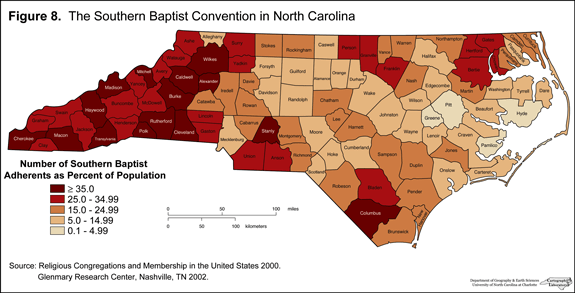The Southern Baptist Convention
by Alfred W. Stuart
Professor Emeritus of Geography, University of North Carolina at Charlotte, 2010.
Reprinted with permission from The North Carolina Atlas Revisited. Managing editor: Alfred W. Stuart.

The large Southern Baptist church congregations increased in number by 190 between 1990 and 2000. The average congregation is relatively large, averaging 407 adherents in 2000. As Figure 8 shows above, they were found in every one of the state’s 100 counties. The greatest relative concentrations are found in western North Carolina and in the northeastern and southeastern corners of the state. On the other hand, the smaller proportions (which still account for 10% to 15% of the population--more than almost any other denomination) are in the central part of eastern North Carolina, along with central counties of the some of the larger metro areas, notably Forsyth, Mecklenburg and Orange counties. In fact, proportions of Baptist adherents are smaller throughout much of the Piedmont corridor but, here again, in most areas Baptists make up between 10% and 20% of the total population, levels that are far higher than other denominations. These levels appear low only in comparison with the 40% or higher levels that are prevalent in nearby western counties, such as Cleveland, Rutherford, Burke, Caldwell, and Wilkes.
Additional Resources:
2012 Statistical Abstract. Population: Religion. U.S. Census Bureau. http://www.census.gov/library/publications/2011/compendia/statab/131ed/p...
Guide to Researching the History of Religion in North Carolina: Baptist Church. UNC-Chapel Hill Libraries. https://guides.lib.unc.edu/religious-studies
Hartford Institute for Religion Research. http://www.hartfordinstitute.org/
State Membership Report, North Carolina. The Association of Relgion Data Archives (ARDA) https://www.thearda.com/
31 October 2010 | Stuart, Alfred W.